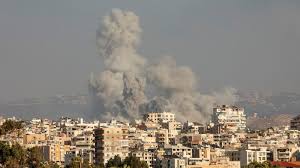Israel escalates attacks on Lebanon, marking a significant turning point in the ongoing conflict. The recent bombardment has resulted in a staggering death toll, with at least 105 Lebanese citizens losing their lives in a single day of relentless strikes. This escalation comes in the wake of Israel’s assassination of Hezbollah leader Hassan Nasrallah, pushing the region closer to the brink of a wider war. As the violence spreads beyond the border regions, both civilian populations and political landscapes are facing unprecedented challenges.
Widespread Destruction and Civilian Casualties
The Israeli military’s campaign has left a trail of destruction across Lebanon, with attacks targeting not only suspected Hezbollah positions but also residential areas. In a particularly devastating incident, two residential buildings in Ain al-Delb near the southern city of Sidon were flattened, resulting in the deaths of 32 people, many of whom were displaced families seeking refuge. The bombardment has struck various regions, including southern Lebanon, the Bekaa Valley, and the Baalbek-Hermel governorate.
In an alarming development, Israel has extended its attacks to include the heart of Beirut for the first time in years. This expansion of the conflict zone has shattered the perception of the Lebanese capital as a safe haven from Israeli strikes. The bombing of municipal Beirut killed at least three people and signals a dangerous new phase in the hostilities.
The human cost of this escalation is immense. Beyond the rising death toll, Lebanese Prime Minister Najib Mikati reports that up to 1 million people have been displaced by the violence. This mass exodus represents one of the largest displacement crises in the region’s recent history, with approximately 118,000 displaced individuals staying in 778 designated shelters. However, the true scale of displacement is likely much larger, as many have sought refuge with friends and relatives or rented their own accommodations.
Hezbollah’s Response and Regional Implications
Despite the heavy losses inflicted by Israeli attacks, including the assassination of its leader Hassan Nasrallah and senior political official Sheikh Nabil Kaouk, Hezbollah continues to launch retaliatory strikes against Israel. The group has announced several military operations targeting Israeli bases and has conducted rocket attacks on Israeli cities, including Safad.
The conflict is no longer contained to the immediate border region between Israel and Lebanon. Yemen’s Houthi rebels and Iran-linked Iraqi armed organizations have entered the fray, firing missiles and drones at Israel in support of Hezbollah and Palestinian groups in Gaza. This widening of the conflict has prompted Israel to carry out air raids on ports and power plants in Yemen, further escalating regional tensions.
The situation remains fluid, with Hezbollah yet to announce succession plans for its slain leader. The group has dismissed media reports about organizational changes, insisting that any news about leadership transitions will only be confirmed through official statements. This uncertainty adds another layer of complexity to an already volatile situation.
Humanitarian Crisis and International Concern
The escalating violence has triggered a severe humanitarian crisis in Lebanon. Thousands of people have been forced to flee their homes with little notice, often leaving with few belongings. Many displaced individuals are now living in precarious conditions, sleeping on Beirut’s streets and beaches. Aid organizations are struggling to cope with the influx of displaced persons, many of whom are traumatized and facing an uncertain future.
The international community has expressed growing concern over the widening conflict. The risk of a full-scale war between Israel and Lebanon looms large, with potential implications for the entire Middle East region. Diplomatic efforts to de-escalate the situation have so far yielded little success, as both sides continue to engage in tit-for-tat attacks.
The conflict’s impact extends beyond the immediate region, with worldwide protests erupting in solidarity with Gaza and Lebanon. Demonstrators in various countries have called on Israel to end its military campaigns, highlighting the global dimensions of this escalating crisis.
As Israel escalates attacks on Lebanon, the region stands at a critical juncture. The devastating toll on civilian lives, the massive displacement of populations, and the potential for further escalation paint a grim picture of the days to come. The assassination of Hezbollah’s leader has opened a new chapter in the conflict, with far-reaching consequences that extend beyond the borders of Lebanon and Israel.
The international community faces an urgent challenge to prevent the situation from spiraling into a wider regional war. As the death toll rises and infrastructure crumbles, the need for a diplomatic solution becomes ever more pressing. However, with both sides seemingly entrenched in their positions and regional actors joining the fray, finding a path to peace appears increasingly difficult.
The coming days and weeks will be crucial in determining whether this escalation can be contained or if it will ignite a larger conflagration in the Middle East. As the world watches with bated breath, the lives of millions hang in the balance, caught in the crossfire of a conflict that shows no signs of abating.
Related News
















